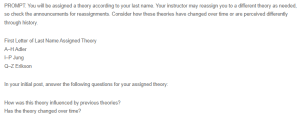Response – Erik Erikson’s Psychosocial Theory
Hello Courtney,
Thank you for sharing your post. Your discussion of Erik Erikson’s Psychosocial Theory is well-detailed. It should, however, be noted that through the integration of social and cultural considerations into Freud’s psychosexual stage theory, Erikson brought a revolution in developmental psychology. While Freud explored the childhood sexual aspects related to erogenous zones of the body through psychoanalysis, Erikson explored the lifelong social aspect, as asserted by Orenstein and Lewis (2022). This shift recognizes that processes are not intrapsychic alone but also social, providing a better explanation of intrapsychic processes.
Furthermore, this theory is broad enough to accommodate new concerns, such as technology and the changes in the structure of families. Such flexibility contradicts Freud’s structural model, primarily grounded in the initial development phases. Hence, adding the sociocultural elements contributes to the practicality of Erikson’s theory across various contexts, enhancing its applicability in contemporary theoretical and empirical work on identity formation and the developmental outcomes of social change.
References
Orenstein, G. A., & Lewis, L. (2022). Erikson’s Stages of Psychosocial Development. National Library of Medicine; StatPearls Publishing. https://www.ncbi.nlm.nih.gov/books/NBK556096/
ORDER A PLAGIARISM-FREE PAPER HERE
We’ll write everything from scratch
Question
PROMPT: You will be assigned a theory according to your last name. Your instructor may reassign you to a different theory as needed, so check the announcements for reassignments. Consider how these theories have changed over time or are perceived differently through history.

Response – Erik Erikson’s Psychosocial Theory
First Letter of Last Name Assigned Theory
A–H Adler
I–P Jung
Q–Z Erikson
In your initial post, answer the following questions for your assigned theory:
How was this theory influenced by previous theories?
Has the theory changed over time?
READING RESOURCES: The Personality Puzzle, Chapter 10
https://eds-p-ebscohost-com.ezproxy.snhu.edu/eds/detail/detail?vid=0&sid=d084b45b-9630-4a8b-a9b3-30a7bf5babf2%40redis&bdata=JnNpdGU9ZWRzLWxpdmUmc2NvcGU9c2l0ZQ%3d%3d#AN=2014-21954-001&db=psyh
https://eds-p-ebscohost-com.ezproxy.snhu.edu/eds/detail/detail?vid=0&sid=b2673024-9d68-4e8d-8b14-2cf069680849%40redis&bdata=JnNpdGU9ZWRzLWxpdmUmc2NvcGU9c2l0ZQ%3d%3d#AN=S0165178118311338&db=edselp

